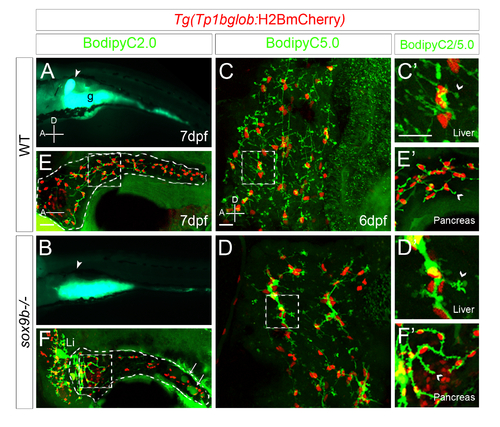Fig. S3
|
sox9b mutants show defects in bile secretion and transport as assessed by BODIPY-FL analog feeding. (A?B) Fluorescent micrographs of 7 dpf live wild-type (A) and sox9b mutant (B) larvae after BODIPY feeding showing lack of filling of the gallbladder (arrowhead) in sox9b mutants (B). Lateral views, anterior (A) to the left. (C?F) Confocal images of Tg(Tp1bglob:H2B-mCherry) wild-type (upper panel) and sox9b mutant (lower panel) larvae showing morphological and functional defects of both intrahepatic (D) and intrapancreatic (F) ductal networks compared to wild-type (C and E). In the mutants, both intrahepatic and intrapancreatic ducts appear to be dilated (D and F). Fluids (bile or pancreatic juice) also appear to accumulate in the pancreatic tail (arrows, F). Dashed squares represent areas shown in higher magnification for intrahepatic (C′?D′) and intrapancreatic (E2?F2) ducts in wild-types (upper panel) and sox9b mutants (lower panel). sox9b mutants showed defects in bile canaliculi (comparing arrowheads in C′, D′) and terminal pancreatic ducts (comparing arrowheads in E′, F′). 9 larvae were analyzed for each genotype. (C?F) All images are projections of confocal z-stacks. (C?F) Lateral views, anterior (A) to the left. Dashed lines in E and F outline the pancreas. g, gut; Li, liver. Scale bars, 20 μm. |

